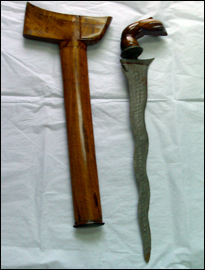A museum in Malaysia is the first in that country to use RFID to track its artifacts. During the next three to four years, the National Museum in Kuala Lumpur will tag a million relics, as well as the shelves used to store them.
The Malaysian government has been encouraging the development of Malaysia as an RFID hub (see RFID’s Silk Road). The government placed a tender on the market and selected an RFID-based museum management application designed by CBS Technology, based in Kuala Lumpur, using CBS’s Solmate software. CBS and one of its resellers, Garisan Aspirasi, are implementing the application. The project began in December 2006, while the tagging of 1,000 weapons, as well as the museum’s storage shelving, started in April.

The Department of Museums Malaysia (DMM), which manages more than 20 museums around the country, sought the application to help it become more efficient in managing them, and to better identify and track the pieces of clothing, ceramics, weapons and works of art on display. Many relics are kept in humidity- and temperature-controlled vaults beneath the museums. These artifacts are often shared among museums, and the RFID system will help track such inter-museum loans.
At present, artifacts are identified by means of a cardboard tag, on which a museum employee writes down an ID number and other information, such as the relic’s owner and period. The cardboard tag is then tied to the object by means of a string, which also passes through a hole in the cardboard tag. Some information about the artifacts is in digital form, but no link exists between the data written on the cardboard and the database of facts and figures about the relics. What’s more, says Ken Lee, chief technology officer of CBS, the cardboard tags frequently fall off because the string rips through the cardboard.
The DMM had considered a bar-coded label but decided RFID was a better choice since it’s available in so many shapes and sizes. The department is now working with CBS to design a passive tag specific to each type of artifact. For instance, it plans to sew tags into 18th-century clothes that once belonged to a sultan.
In the first phase of the project, CBS is training DMM staff how to tag weapons. The staff is currently in the process of applying the high-frequency tags, which are made of flexible plastic, come from various makers and conform to the ISO 15693 standard. The staff hangs them on weapons using custom-designed string that won’t harm the artifacts. Each type of string is approved for a specific weapon. When plastic tags are used, the string cannot break through the hole as easily as it does with cardboard. All interrogators in the project come from Omron.
To tag an artifact, a staff member sits at a desk and employs a stationary RFID interrogator to register the item in the database and encode information to its tag. The artifact’s ID number, type, owner and storage location are all encoded to the tag. When a relic is returned to the proper storage shelf, an employee uses a handheld reader to scan the item’s tag, then links it, within the database, to the proper shelf number, indicated on the shelf tag.
When the National Museum receives a loan request from another institution, it notes the request in its computer system, which indicates the location and tag number of the shelf on which the item is stored. A staff member then goes to the specific shelf with a handheld RFID interrogator, reading all items in the area upon arrival. In the past, since many relics look the same, the process of locating a specific item could take up to two hours.
Once it identifies the proper relic, the interrogator beeps and the worker takes the object to a staging area, where a manager approves the loan on the computer system. The item is packed for shipping, and its tag is interrogated again before it leaves the premises, via a desktop reader near the exit. The computer system notes the date when the item was shipped, as well as the museum to which it was sent.
Upon the object’s return to the National Museum, workers interrogate the tag once more before returning it to storage. Lee says the DMM has not calculated an ROI for the project, but that the RFID-based system will increase productivity and enhanced efficiency.


